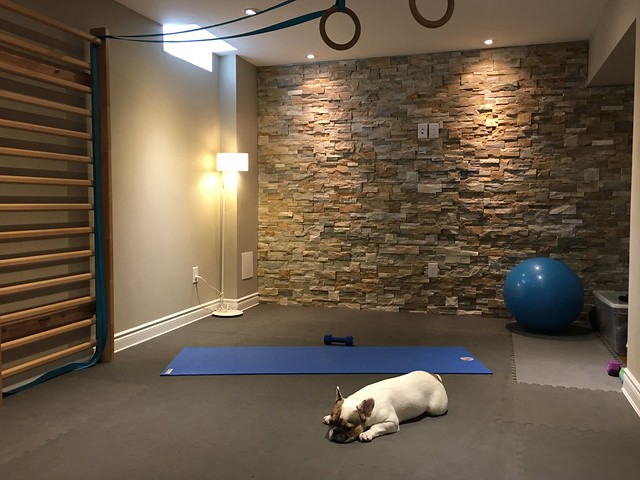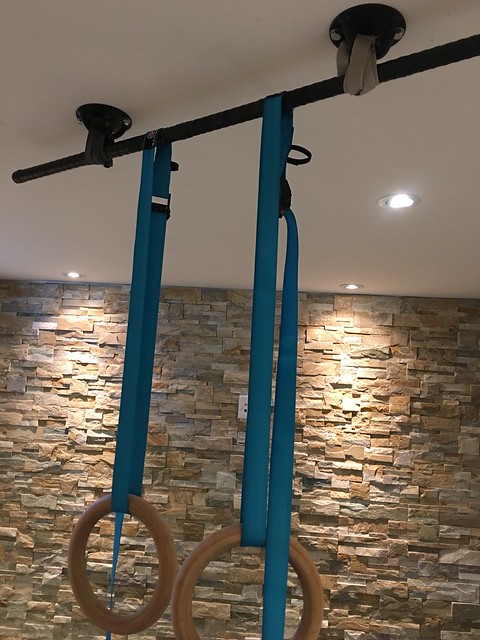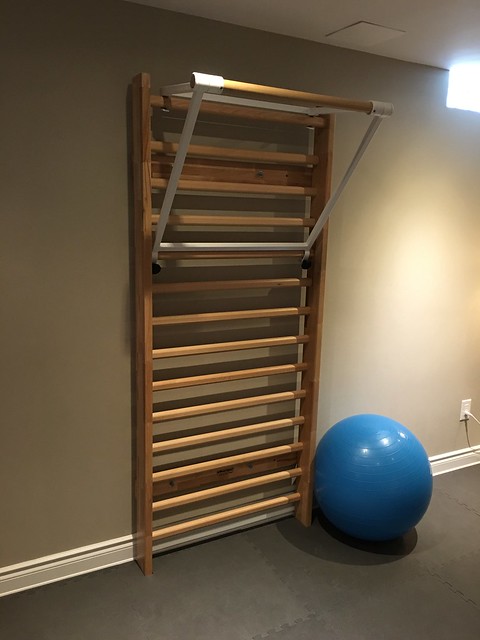You are here
Suggestions for a Home Gym
Suggested Resources for a Home Gym
A number of readers have asked for some thoughts on setting up a home gym. Being a minimalist in most spheres of life, I enjoy just a handful of tools that help me use movement with my own body weight to improve mobility and functional strength.
Let's start from the ground up, shall we?
If you don't have a comfortable surface that provides a good blend of grippy support and cushion, you might consider some interlocking high density foam mats. I purchased a commercial grade product a few years ago that I've been happy with, but the manufacturer has since gone out of business. The mat tiles that I ordered are 1.1 inches thick. I was able to find the same material and texture at Amazon, though 0.5 inches thick - you can view this here:
Interlocking High Density Floor Mats
I think for most purposes, 0.5 inches thickness is sufficient, and I have worked with this mat firsthand, so I can vouch for its quality.
Next, I feel that it is immensely helpful to have mounts overhead that you can use to install a bar or gym rings on. If you have structural beams or joists already accessible, then all the better. But if you need to create an anchor point on a wood joist through drywall, I would suggest the following mount or something like it:
There are non-branded ones that sell for around $15 at some retailers - in Canada, you can find such mounts at TreadMillFactory.ca.
I like these mounts with round plates because the plates have a large enough surface area to disperse the weight of a substantial load, which protects drywall from being damaged.
To properly install these wall mounts onto joists to safely allow for body weight work, I would suggest consulting with an experienced handy person or contractor if you don't have experience drilling into joists.
If you don't have firsthand experience with securing heavy items to joists but are keen to do it yourself, once you locate the joist that you want to secure your mount to (by percussion or via use of a stud-finder), I would suggest drilling small pilot holes to be sure that you have wood behind your target points. To ensure that your joists don't crack when you screw your wall mounts in place, drill a hole into your target points that is about a quarter inch smaller in diameter than the diameter of your screws at their widest point - this will make for easier turning of your bolts as well.
If you install two mounts into your ceiling, I would suggest using two adjacent joists rather than putting both of your mounts into one joist, just to have more weight capacity with each mount. The mount suggested above has a capacity of 300 pounds, so with two mounts in two separate floor joists, you'll safely have 600 pounds of load capacity to work with.
If you know that you'll be working exclusively with rings, I would suggest securing your mounts about shoulder width apart. I installed my mounts quite a bit wider than this without knowing better, so when I realized that I wanted to have varying widths to work with, I used heavy nylon straps to secure a 4-foot galvanized steel bar to my wall mounts, effectively creating a wide pull-up bar that I can work on directly, or secure my rings to at varying widths.
For better grip, I wrapped the steel bar with tacky overgrip that one would normally wrap over the grip of a tennis racquet - about 5 overgrips were enough to cover the 4-foot bar.
I encourage you to think about what your needs are, and if your needs can be met with resources that already exist, such as monkey bars at a local playground or a thick branch of a strong, healthy tree, then all the better.
Or if you are feeling ambitious about creating something for yourself and you have outdoor space to work with, you might consider finding a way to install actual monkey bars - a lot to consider, including your goals, climate, budget, and how much footprint you have to use. I have a skin condition that doesn't allow me to be out in the sun for long stretches at a time, and my work space is quite limited, which is why I went with wall mounts in the ceiling - creating zero footprint was a top priority for me.
For rings, I like and use two varieties:
These wood gym rings are thicker in diameter than the plastic ones. I like their natural feel and also their sturdiness. The only downside I have found is that when the air is quite dry, I feel I can't get a secure grip on these rings, which makes it necessary to use chalk, which I would rather avoid.
These plastic rings have some texture to them, and establishing a secure grip without chalk has not been an issue. They are thinner in diameter than the wood rings, so they may be easier to work with for those who have smaller hands. My hands are somewhat large for my body structure, but I have not found these rings to be difficult to work with. I also prefer the straps that come with these rings over the straps that come with the wood rings listed above - these straps are thicker and their braking mechanism seems to have a smarter design with little to no potential of breaking.
If you don't already have resistance bands to work with, I can recommend the following:
But for more diverse bands that can be used for a wider range of exercises, I can strongly suggest the following type:
An exercise ball, yoga mat, and a few light dumbbells (from 2 to 8 pounds) can also come in handy with certain exercises - these resources are readily available in big box stores. The same holds true for a foam roller. We don't make our own foam rollers anymore because we can't produce enough volume to offer them at great value, but thankfully, all of us have access to the GRID roller which is as good as it gets in the industry, excellent for improving circulation through all major muscle groups and for improving mobility through the hips and spine:
One final tool that I find immensely valuable for mobility work is Gymnastics Stall Bars, sometimes called Gym Wall Bars.
Here is a look at the set that I have installed in my work space:
The white metal pull-up bar was optional - I got it because our boys love monkeying around with me in my work space, so an extra place to hang from without taking up additional footprint was a welcome addition.
Stall bars allow for all sorts of mobility and functional strength work. Once I finish filming a comprehensive range of exercises that one can do on stall bars, I'll be sure to upload everything to our YouTube Library, but in the meantime, if you're curious about its range of applications, may the Search function at YouTube be your friendly guide.
As with installing wall mounts, there is some work involved with securing Stall Bars. Ideally, they are bolted to studs, so if you don't have experience with this sort of thing, you'll want to commission a competent handy person to help you.
I ordered our Gymnastics Stall Bars and the detachable pull-up bar from the following company in Europe:
If you order stall bars, be sure to consider the height of your work space. The detachable pull-up bar can be found here:
Pull-up Bar for Stall Bars at Artimex
In speaking with the owners of Artimex about my desire to encourage people to improve mobility through exercises from a wide variety of disciplines but mostly from gymnastics, for people from our readership, they generously offered to include a special gift with every order of Stall Bars. So if you order Stall Bars from Artimex, in the order comments section, be sure to indicate that you are a part of our online community (simply writing "Dr. Ben Kim" in the order comments section is sufficient). As of this writing, the gift for those in our community is a $40 USD padded guard that you can attach to your stall bars with velcro straps to make a number of exercises more comfortable - quite helpful to those of us who aren't seasoned gymnasts, right?
I hope some of these suggestions prove to be helpful to your journey of self care. Even without any equipment at all, there are countless simple exercises that any of us can do from any spot on the planet to improve mobility and functional strength. If you haven't commenced with developing a regular practice of mobility work, I encourage you to visit our YouTube library and consider ways that you can gradually liberate your body from everyday niggles and stiffness. If you ever have any questions or would like some feedback, please don't hesitate to write to me at benkim@drbenkim.com.
Join more than 80,000 readers worldwide who receive Dr. Ben Kim's free newsletter
Receive simple suggestions to measurably improve your health and mobility, plus alerts on specials and giveaways at our catalogue
Please Rate This
Highest RatedNo articles have been rated for usefulness recently, please check later. | Related Posts | ||














Comments
Dr. Kim
As always Dr. Kim....
I appreciate your spirit and contributions to our health and well being. You are a gift to us all. Thank you.